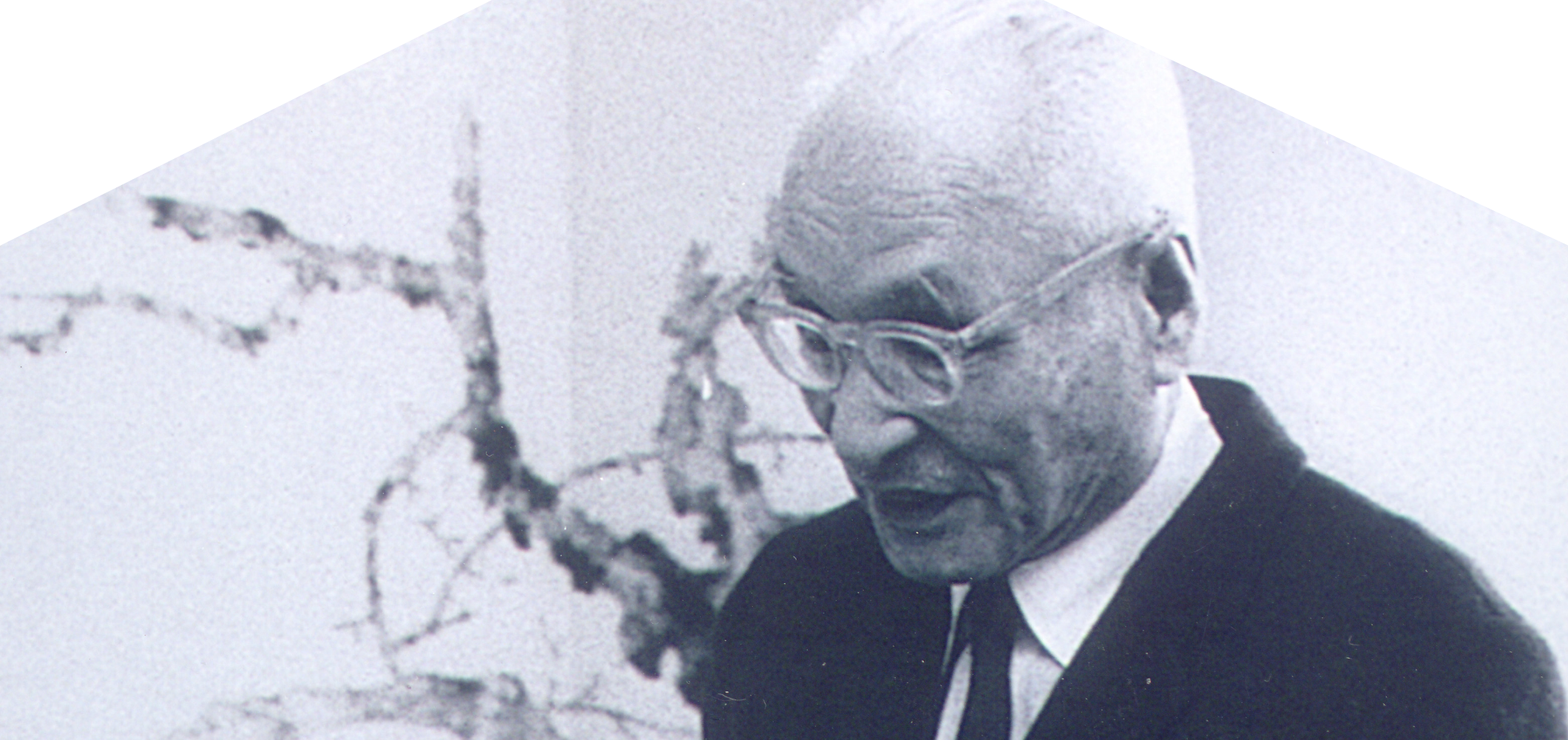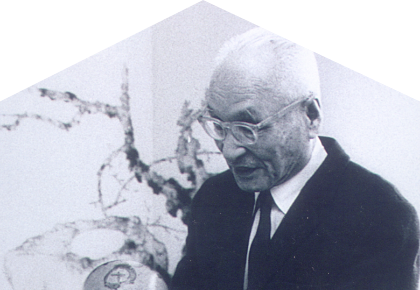- TOP
- About Idemitsu Sazo
-
Early Life
Idemitsu Sazo was born on August 22, 1885, in Akama village, Munakata district (present-day Akama, Munaka city) in Fukuoka prefecture as the second son of Tōroku, his father who was an indigo wholesaler and Chiyo, his mother.
After graduating his local schools, Sazo aspired to become a diplomat at first, but his father’s teachings of “jishu dokuritsu (self-independence)” led him to enter Fukuoka Commercial School and later continue his studies at Kobe High School of Commerce. In 1911, Sazo established Idemitsu Shokai (current Idemitsu Kosan Co., Ltd.) and began his career as an entrepreneur. -

Idemitsu Sazo and “Tea Bowl with Design of Cross-in Circle”
-
Life as a Collector
—Discovering SengaiIn 1905, when Sazo was still a 19-year-old student, he happened to see “Hotei (Budai) Pointing at the Moon” by the Zen master Sengai at an antique shop in Hakata city. Although this was before Sengai became well-known, Sazo pleaded his father to purchase the work. This Zen painting became the celebratory beginning to the Idemitsu collection.
Since then, the collection continued to grow in both quantity and quality. Beginning with Sengai’s work, the collection encompasses exquisite pieces of art, including bunjin-ga (literati painting) by artists such as Tanomura Chikuden, Chinese ceramics and bronze works, Japanese ceramics such as Ko-Garatsu and Ko-Kutani, painting and ceramic work by modern artists such as Kosugi Hōan and Itaya Hazan, and even Western paintings by Georges Rouault and Sam Francis. The collection further houses work designated as National Treasures such as Kohitsu Tekagami (Album of Exemplary Calligraphy) “Minuyo-no-Tomo” and Important Cultural Properties including “Portrait of Poet Kakinomoto no Hitomaro with His Poem, Satake Version,” “Wild Geese Alighting on the Sands” by Muxi and “Tea Leaf Jar with Design of Poppies” by Nonomura Ninsei. -

“Hotei (Budai) Pointing at the Moon” Sengai (1750-1837) 19th Century
-
Founding of the Museum
Although Sazo was well-known as an entrepreneur who was successfully leading Idemitsu Kosan Co., Ltd., he had always wished to create his own art museum. His dreams had come true in 1964 when Idemitsu Art Gallery in Fukuoka opened within the building of the Fukuoka branch of Idemitsu Kosan Co., Ltd. However, he decided to open a fine art museum in Tokyo, where the company headquarter was located. Around 1951, he began to organize the artworks in his possession and in 1966, opened the Idemitsu Museum of Arts — which was based on his collection of fine arts from the East — on the 9th floor of the Teigeki building. Further, in the same year of the Museum’s opening, Sazo left his position as the President of Idemitsu Kosan Co., Ltd. and became the Director of the Museum.
-

View of Teigeki Building
-
Sazo in His Late Years
The last work to be collected by Sazo was “Two Cranes” by Sengai. On the work, there is an inscription with the saying, “Cranes have a life of one thousand years; Turtles have a life of ten thousand years,” which is an expression for long life. After that, the inscription continues, “I have a life of the heaven’s mandate,” which expresses an appreciation for the life that was given by the heaven, instead of longing for longevity. It is well-known that Sazo used to repeat this phrase. As such, the history of the Idemitsu collection that began with the acquisition of “Hotei (Budai) Pointing at the Moon” ended with the acquisition of “Two Cranes.”
Reflecting on his late years, Sazo stated that “my life is about seeing art with my eyes and beauty of people with my heart. I feel I’ve always been led by what is called beauty.” Sazo, who had endeared the Japanese traditions of beauty, poured his heart into collecting, preserving, and holding exhibitions of such arts. Since the opening of the Museum, Sazo devoted his late years to two goals: expanding his collection and the spreading of Japanese Arts. He realized numerous exhibitions and supported archaeological research excavations in Japan and abroad.
Idemitsu Sazo’s important messages behind these works have been passed down by through the Museum until today. -

“Two Cranes” Sengai (1750-1837) 18th Century





